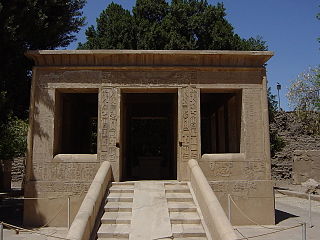| Senusret in hieroglyphs |
|---|
Senusret (Greek: Sesostris; also transcribed as Senwosret based on Coptic; and as Usertesen in older literature) is the name of several Ancient Egyptians:

Coptic, or Coptic Egyptian, is the latest stage of the Egyptian language, a northern Afro-Asiatic language spoken in Egypt until at least the 17th century as an official language. Egyptian began to be written in the Coptic alphabet, an adaptation of the Greek alphabet with the addition of six or seven signs from Demotic to represent Egyptian sounds the Greek language did not have, in the 1st century AD.

Ancient Egypt was a civilization of ancient North Africa, concentrated along the lower reaches of the Nile River in the place that is now the country Egypt. Ancient Egyptian civilization followed prehistoric Egypt and coalesced around 3100 BC with the political unification of Upper and Lower Egypt under Menes. The history of ancient Egypt occurred as a series of stable kingdoms, separated by periods of relative instability known as Intermediate Periods: the Old Kingdom of the Early Bronze Age, the Middle Kingdom of the Middle Bronze Age and the New Kingdom of the Late Bronze Age.
- Senusret I, pharaoh (12th Dynasty)
- Senusret II, pharaoh (12th Dynasty)
- Senusret III, pharaoh (12th Dynasty)

Sesostris was the name of a king of ancient Egypt who, according to Herodotus, led a military expedition into parts of Europe.

Conflation is the merging of two or more sets of information, texts, ideas, opinions, etc into one, often in error.
- Senusret IV, pharaoh (13th or 16th Dynasty)
- Senusret (vizier)
- Senusret (nomarch), 12th Dynasty nomarch at Elkab

Senusret I, also anglicized as Sesostris I and Senwosret I, was the second pharaoh of the Twelfth Dynasty of Egypt. He ruled from 1971 BC to 1926 BC, and was one of the most powerful kings of this Dynasty. He was the son of Amenemhat I. Senusret I was known by his prenomen, Kheperkare, which means "the Ka of Re is created."

Khakheperre Senusret II was the fourth pharaoh of the Twelfth Dynasty of Egypt. He ruled from 1897 BC to 1878 BC. His pyramid was constructed at El-Lahun. Senusret II took a great deal of interest in the Faiyum oasis region and began work on an extensive irrigation system from Bahr Yussef through to Lake Moeris through the construction of a dike at El-Lahun and the addition of a network of drainage canals. The purpose of his project was to increase the amount of cultivable land in that area. The importance of this project is emphasized by Senusret II's decision to move the royal necropolis from Dahshur to El-Lahun where he built his pyramid. This location would remain the political capital for the 12th and 13th Dynasties of Egypt. The king also established the first known workers' quarter in the nearby town of Senusrethotep (Kahun).

Khakaure Senusret III was a pharaoh of Egypt. He ruled from 1878 BC to 1839 BC during a time of great power and prosperity, and was the fifth king of the Twelfth Dynasty of the Middle Kingdom. He was a great pharaoh of the Twelfth Dynasty and is considered to be, perhaps, the most powerful Egyptian ruler of the dynasty. Consequently, he is regarded as one of the sources for the legend about Sesostris. His military campaigns gave rise to an era of peace and economic prosperity that reduced the power of regional rulers and led to a revival in craftwork, trade, and urban development. Senusret III was among the few Egyptian kings who were deified and honored with a cult during their own lifetime.
| This page or section lists people that share the same given name. If an internal link led you here, you may wish to change that link to point directly to the intended article. |










